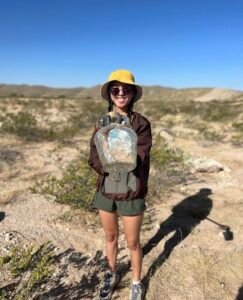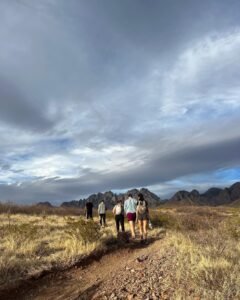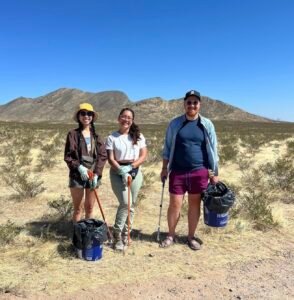En el Campo, Exploring Public Lands: A Q&A with Kyla Navarro of Friends of Organ Mountains-Desert Peaks
September 20, 2022
Editor’s Note: Kyla is the Policy and Community Coordinator for Friends of Organ Mountains-Desert Peaks (Friends of OMDP) and an active member of the People, Public Lands and Climate Collaborative (Collaborative), serving as one of its co-chairs.
-
Tell us about yourself and your role in the Collaborative:

Tell us about yourself, your role in the Collaborative and how your organization envisions its continued presence within this Collaborative:
This year, I am one of the co-chairs of the Collaborative. I am part of a smaller public lands group dedicated to the protection and advocacy of a national monument. Friends of OMDP accomplished a great feat during its first five years: getting a national monument designated! Such designations, under the Antiquities Act, can be taken away as easily as they can be granted. We want more of our community to be connected to the surrounding public lands: to ensure the continued protections of the national monument but also to address the current inequity in our outdoor spaces. The community we serve is a Latinx/e and/or Hispanic, but those who use our public lands aren’t representative of that.
Our organization sees the Collaborative as an opportunity to connect bigger organizations to ones that are more community oriented. -
How do you enjoy public lands?
I think there is a stereotypical idea of what an “outdoorsy person” is, and I simply do not fit that. I have a bit of imposter syndrome for not being an avid outdoor enthusiast. I enjoy my time with the Friends of the Organ Mountains-Desert Peaks, learning about different areas’ history, the flora, and fauna. However, I do not rock climb or go backpacking. It scares me to do those things. My favorite way to enjoy public lands is to take a deep breath, slow down, and get to my destination (the end of the trail) at my pace. I also like hammocking: suspending myself a few inches off the ground to read is great!
-
How does your work and contributions, as well as those of your team in the Collaborative, advance your policy and advocacy goals?
We find it incredibly valuable for people in b
 igger organizations to hear the stories and perspectives of those living in less-populated communities. Friends of OMDP is located in New Mexico – a state that is often forgotten, and even within our own state, the southern portion tends to be left out and underfunded. The Collaborative gives us an opportunity to truly spotlight our work to bigger environmental groups, and to government agencies.
igger organizations to hear the stories and perspectives of those living in less-populated communities. Friends of OMDP is located in New Mexico – a state that is often forgotten, and even within our own state, the southern portion tends to be left out and underfunded. The Collaborative gives us an opportunity to truly spotlight our work to bigger environmental groups, and to government agencies. -
What is the connection between public lands, climate action, and community in the work of your organization? How does it connect your organization’s mission? (Consider any lenses used to do this work, core values and equity.)
As a first-generation immigrant, I was rather oblivious to what public lands are. My family, and I would say myself, are not outdoorsy and could not imagine ourselves as such. After starting a job at the Friends of OMDP, I was finally exposed to the magnificence of the Chihuahuan Desert. Even after living in Southern New Mexico for half of my life, I had a fairly complicated relationship with my environment. But there is definitely beauty in the thorny plants and the scaly creatures that speed through the desert.
I understand that I am not the only immigrant in this region who feels a strained relationship with their environment, but I see our organization playing a role in connecting more people to the outdoors. Our mission is to protect and restore our national monument for the enrichment of our community. As vast as our national monument is, the outdoor spaces are still mostly used by white individuals in our community. Doña Ana County is a remarkable location as it is part of the borderlands. Our community is a minority majority, providing us a great opportunity to engage with people who statistically do not utilize public lands to the same extent as white individuals. -
How do public lands help foster a more inclusive understanding of community and the world? How can this be expanded?
In my experience, the outdoor space tends to be predominantly white. I think there needs to be more of an effort to highlight the non-traditional ways people are using and exploring public lands. We all have this idea, this image, of what it means to be outdoorsy because representation is lacking to show us otherwise. And this image or idea is not reflective of our communities. There is great opportunity for our idea of outdoorsy to be expanded: one can be outdoorsy by simply enjoying natural spaces. Whether that’s playing basketball in your local park, camping, fishing, or having a picnic, it should all be included in our idea of enjoying our outdoors.
-
Why do you believe we need to protect public lands?

I believe that public lands can be a fantastic tool for addressing climate change. We produce fossil fuels on our public lands and advocating for the protection and restoration of various lands ensures that we eliminate a substantial amount of fossil fuel production and fight global warming! Public lands, especially lands that are in the vicinity of communities, contribute to the well-being of so many people. The health of our natural spaces is indicative of the health of people; these two components are connected, in tandem. Our public lands ensure we have clean air and clean water!
We have a very utilitarian view of our land, and we don’t have to. Restoring and protecting our land from degradation serves us in ways that aren’t so immediate. It doesn’t have to be a space for us to recreate but it can safeguard our airs and waters in ways we don’t see! -
What is the top action you’d like to see Congress and/or the Biden-Harris Administration take to preserve, protect and restore public lands?
Our organization believes that the Inflation Reduction Act was a step towards climate action. However, we wish to see more regarding protection of our public lands. We understand that the Bureau of Land Management handles so much land: we hope to see that the agency is well-funded in order to properly take care of these spaces for our communities and for generations to come.
-
What are actions individuals can take to help advocate for public lands, our natural world and especially for all people to access these spaces?
There are a multitude of reasons why people of color do not explore public lands and our outdoor spaces. I think something incredibly important individuals can do is help a friend feel safe and comfortable going outside on a trail. Creating a more inclusive outdoors involves us coming together to address insecurities certain people face regarding the outdoors.
-
Prioritizing wellness and self-care is important in the work we do. How do you create space to connect with the outdoors?
Funny enough, I connect the outdoors through my work. As a first-generation immigrant, I didn’t really feel comfortable exploring public lands on my own or felt safe going to the wilderness. It’s not my idea of a great time. My work taught me that the outdoors is best explored with people–with community. It’s nice to connect with friends and family while hiking on the trails–or hammocking among a few trees (not a lot of trees out where I am).
Honestly myself care often looks like baking, reading novels, or binge watching a series my friends told me to watch ages ago.